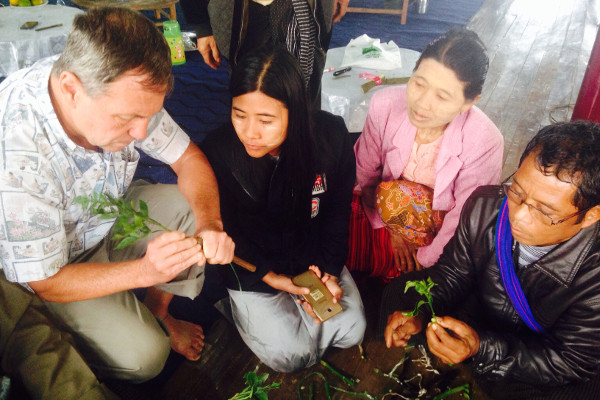
Volunteer Post
Hawaii Farmer Shares His Knowledge With Citrus Farmers in Myanmar
F2F Volunteer, David Ringuette
This week’s blog comes from Farmer-to-Farmer (F2F) volunteer, David Ringuette. Mr. Ringuette owns and manages Serikaku Farm Ltd., a 15-acre family farm located in Hawaii which produces cacao, banana, lychee, breadfruit, and star fruit. Mr. Ringuette is a retired agriculture coordinator and professor who taught IPM, pesticide safety, plant propagation, irrigation, and soil management. Since retiring, Mr. Ringuette has successfully completed 11 F2F volunteer assignments, many of which have focused on IPM and production of tropical fruits. He has provided volunteer assistance in East and West Africa, Kyrgyzstan, Dominican Republic, Nicaragua, and now Myanmar.
In September 2017, I had the opportunity to work on a Farmer to Farmer Assignment in Myanmar. The Farmer to Farmer program is funded by USAID and implemented in Myanmar by Winrock International.
During my 2 weeks in country I worked with citrus growers in southern Shan State on implementing IPM practices. It is a very mountainous area where avocados, tea, and coffee are also commercially grown. These crops were developed as a substitution for poppies. The 77 farmers were eager to learn new pest control strategies. I covered citrus nutrient deficiencies, monitoring techniques, grafting, pruning, physical control, biological control, and use of chemicals.
Like everywhere in the world there were some farmers’ orchards that were in great shape and some needed substantial work, especially pruning. Most farmers did not know the difference between a fungus and bacteria and often applied one chemical for control of everything. One orange grower from Kaungbo village in Yaksauk noted, “We decided to apply a chemical (no matter it is) whenever we saw a problem in our plant. After Winrock F2F’s training on IPM, we understand the need to think and inspect the cause- nutritional deficiency? disease? insect? fungus?”

Interestingly, farmers told me that there was more money to be made in citrus than any other orchard crop. They wanted to stick with citrus even with some severe disease pressure. Many orchards were intercropped with tea, tomato, garlic, ginger, or mango. I did not understand the mango/citrus system and it seemed to me there was too much resource competition to be successful. The mango usually out competed the citrus. The garlic, ginger, and tomato system lead to deep cultivation and most likely led to root diseases. The system I thought had good potential was tea and citrus. I did discuss with them about chemical application in a 2-crop system.

The people of Myanmar are very hospitable and accommodating. The lead farmer always had his wife prepare wonderful food for lunch for me and farmers gave me enough tea to start a tea shop. I was also never allowed to carry my bag. I hope, in the future, to return to Myanmar and once again work with these wonderful people.

After Mr. Ringuette’s assignment, he expressed, “The growers were very enthusiastic throughout the training. They asked good questions and expressed a sincere willingness to implement the techniques explained. Many farmers inquired about the purchase of pruning tools.”
